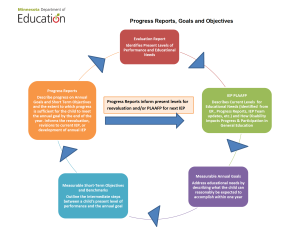Standards-Based IEPs
The What and Why of Standards-Based IEPs
You have read about the IEP requirements. Now, you will start practicing and writing the various components using state and federal guidelines. Specifically, you will focus your attention on writing Standards-based IEPs. You will use resources provided by the Minnesota Department of Education (MDE) to help you. The graphic below provides a quick glance at the required IEP components. You may note that the process is cyclical, and that each piece of the IEP is interdependent, informing the next piece. By the end of this section, you will be able to identify and write the components of a strong statement regarding the child’s Present Level of Academic and Functional Performance (PLAAFP) and start to write annual goals and objectives. This is a brief introduction. As you move forward in your program, you will spend an entire semester practicing these skills.

Standards-based IEPs contain all of the required elements of an IEP, as defined by Minnesota state and national regulations; they are specifically aligned to the content and grade-level standards that all students are expected to know and be able to do. Your work will align with Minnesota Academic Standards. Aligning to academic standards can seem like an overwhelming process due to the number of standards. Once you spend time looking at the standards, you will begin to notice themes and patterns emerging as you move from grade to grade, while the depth and complexity change. You will spend more time in a later class finding and identifying these themes.
According to The National Center on Educational Outcomes, “The IEP team considers state content standards as it develops IEP goals. Standards-based IEPs identify the services, supports, and specialized instruction an individual student needs to access and make progress in the general curriculum based on the state grade-level academic content standards. Standards-based IEPs interpret students’ present levels and specific barriers that may affect their learning in order to provide better access to academic content for students. They also assist in thinking about assessments in which students participate and the access and accommodations needs that an individual student may have.” This is a departure from years of designing interventions and instruction based on a student’s next developmental skill. Prior practice often resulted in programming and instruction that were not necessarily aligned with grade-level peers and lowered expectations and achievement.
